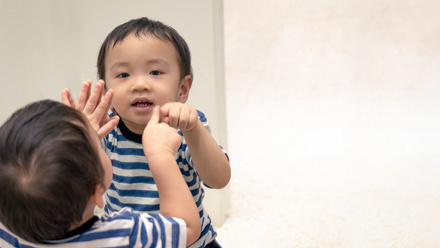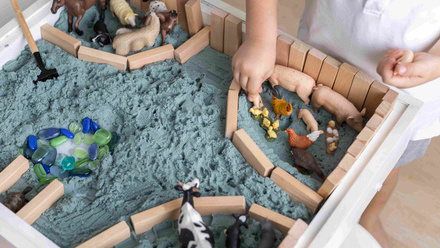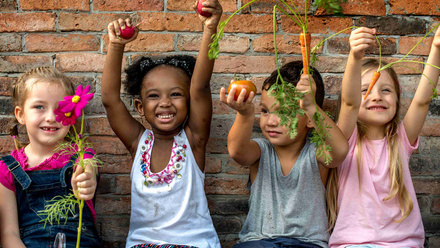Early literacy with babies and young children
The more that you read, the more things you will know. The more that you learn, the more places you’ll go.
Dr Seuss
Reading opens up entire worlds: worlds of fiction where magical creatures exist and wild things roam, and worlds of opportunity where we learn and grow in the real world too.
Our engagement with literacy can have long-lasting impact on life outcomes in a variety of ways. Some, we might expect: lower literacy levels are linked to lower employability, for example. However, studies highlight the wider-reaching effects of literacy on socio-economic factors and even life expectancy.
In this article, we are going to explore how early education and care can build the important foundations for early literacy and give some suggestions for how to increase literacy opportunities for young children.
When we think about literacy, our first thoughts might be of books and reading. It might conjure images of circle time or guided reading. But there is so much more to literacy than the popular impression. Early literacy also refers to:
- comprehension and understanding
- writing
- spelling and grammar
- mark making
- vocabulary
- performance and roleplay
- listening
- …and so much more.
According to research by BookTrust, reading in the early years has an impact on progress across the curriculum at age 16 that is four times the impact of parental education or socio-economic status.
So, we know that reading has long-lasting impact on educational, physical, social and emotional development outcomes, which is why it should be encouraged from the earliest stages – even when a baby is still in the womb! A foetus can hear external sounds from approximately 23 weeks and reading to a baby before they enter the world exposes them to approximately 58,000 more words!
It is important to continue to develop a passion for reading – and reading for pleasure in particular – as babies grow into toddlers and beyond, to sustain their interaction with literacy and allow them to soak up a rich range of vocabulary.
And yet, while 95% of parents and carers agree that reading is important for their children, 28% report finding it tricky to do. Babies’ attention spans aren’t equipped to manage long stories, even the ones with detailed pictures to explore, so it’s important to keep literacy activities engaging.
Whilst babies’ attention spans can differ depending on the environment, their general wellbeing and other varying factors, it is rare for a child under two to maintain complete focus on a story from cover to cover.
When reading stories together, encourage interactivity with the children. Some books designed for babies do this through touch-and-feel aspects and hidden flaps on the pages, but this can also be developed more broadly, through story sacks, sensory journeys and dramatic engagement.
Let’s take a look…
Story sacks
Story sacks are becoming increasingly common in early education and care settings as a way to immerse children in an activity by identifying aspects of the narrative using realia (real-life objects) that represent significant parts of the story.
With babies, a story sack provides a strong opportunity for naming items and connecting them to pictures in the book. For example, a baby might choose a food item from the bag and could be encouraged to then identify it on the page. These activities needn’t be done in time with the story but can be child-led, and flip back and forth through the pages.
A key outcome here focuses on the communication and language aspect of early literacy, developing vocabulary and wider understanding in a fun, open-ended way.
Sensory journeys
Similarly to story sacks, sensory journeys allow children to explore sensory aspects of a story, connecting to the narrative on a different level because they are not looking at the pages of the book itself. This could involve using sensory bottles of water when reading about the seaside, or turning off the lights for a trek into the dark forest.
Get creative with your experience of senses to fascinate young children and create a sustained interest in the story as you explore it in new ways.
A key outcome here focuses on developing listening skills, allowing children to focus on their sensory experiences rather than looking at the pages of a book.
Dramatic engagement
For children as young as two, helicopter stories offer a unique way to engage them in understanding the structure of a narrative and the pleasure of creating a story collaboratively. These opportunities require a greater level of attention but are effective by giving children the autonomy to tell their own stories together.
For young children, dramatic engagement can be incorporated into stories by giving opportunities for actions, such as pretending to be a character, or moving around the room in a way that reflects what is happening.
A key outcome here focuses on being able to communicate with others as well as developing creative thinking and imaginative skills.
The power of literacy is limitless and is an essential area of development for children to thrive in all areas of life. To give children the best start, early literacy should be encouraged from the earliest opportunity to develop strong passions for literacy and confidence to sustain it beyond the early years.
Further resources & readings
Why not explore some of our other member resources for literacy, or check out the NDNA Communication & Language Champions programme or other NDNA literacy courses.






